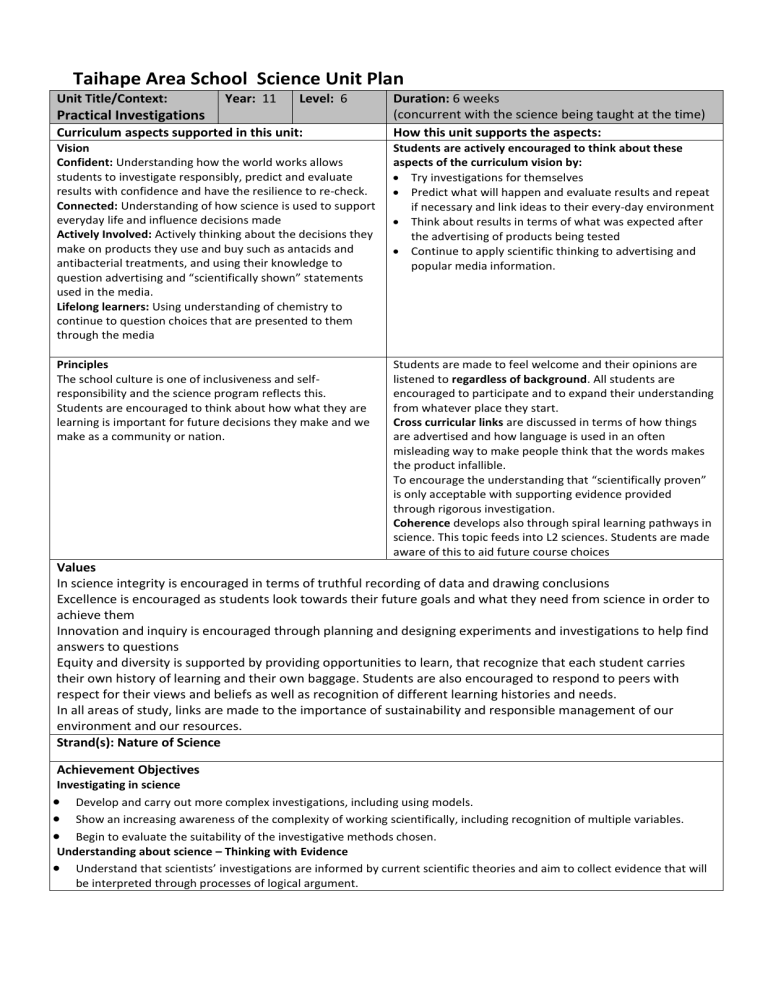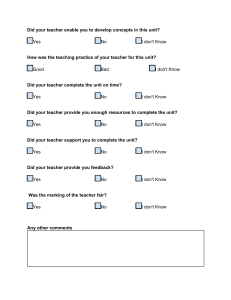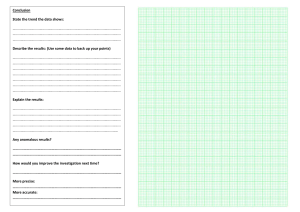Year 11 Science Unit Plan: Practical Investigations
advertisement

Taihape Area School Science Unit Plan Unit Title/Context: Year: 11 Level: 6 Practical Investigations Curriculum aspects supported in this unit: Duration: 6 weeks (concurrent with the science being taught at the time) How this unit supports the aspects: Vision Confident: Understanding how the world works allows students to investigate responsibly, predict and evaluate results with confidence and have the resilience to re-check. Connected: Understanding of how science is used to support everyday life and influence decisions made Actively Involved: Actively thinking about the decisions they make on products they use and buy such as antacids and antibacterial treatments, and using their knowledge to question advertising and “scientifically shown” statements used in the media. Lifelong learners: Using understanding of chemistry to continue to question choices that are presented to them through the media Students are actively encouraged to think about these aspects of the curriculum vision by: Try investigations for themselves Predict what will happen and evaluate results and repeat if necessary and link ideas to their every-day environment Think about results in terms of what was expected after the advertising of products being tested Continue to apply scientific thinking to advertising and popular media information. Principles The school culture is one of inclusiveness and selfresponsibility and the science program reflects this. Students are encouraged to think about how what they are learning is important for future decisions they make and we make as a community or nation. Students are made to feel welcome and their opinions are listened to regardless of background. All students are encouraged to participate and to expand their understanding from whatever place they start. Cross curricular links are discussed in terms of how things are advertised and how language is used in an often misleading way to make people think that the words makes the product infallible. To encourage the understanding that “scientifically proven” is only acceptable with supporting evidence provided through rigorous investigation. Coherence develops also through spiral learning pathways in science. This topic feeds into L2 sciences. Students are made aware of this to aid future course choices Values In science integrity is encouraged in terms of truthful recording of data and drawing conclusions Excellence is encouraged as students look towards their future goals and what they need from science in order to achieve them Innovation and inquiry is encouraged through planning and designing experiments and investigations to help find answers to questions Equity and diversity is supported by providing opportunities to learn, that recognize that each student carries their own history of learning and their own baggage. Students are also encouraged to respond to peers with respect for their views and beliefs as well as recognition of different learning histories and needs. In all areas of study, links are made to the importance of sustainability and responsible management of our environment and our resources. Strand(s): Nature of Science Achievement Objectives Investigating in science Develop and carry out more complex investigations, including using models. Show an increasing awareness of the complexity of working scientifically, including recognition of multiple variables. Begin to evaluate the suitability of the investigative methods chosen. Understanding about science – Thinking with Evidence Understand that scientists’ investigations are informed by current scientific theories and aim to collect evidence that will be interpreted through processes of logical argument. Key Skills: Increase understanding of dependent and independent variables and how to manage them in a practical situation including how they will be set/measured Justify the range of the independent variable Describe control of other significant variables, how they are controlled and justify why they must be controlled showing understanding of science ideas Develop systematic, logical investigation plans Record data systematically and accurately including units Develop data processing skills including graphing, pattern seeking and trend seeking Draw valid conclusions in terms based on the evidence presented by the processed data Evaluate the validity of the conclusion in terms of the method used, the reliability of the results and whether or not it fits the science ideas/expected outcomes Design and carry out a practical investigation with direction (AS90925, 90930, 90935) Key Vocabulary Aim Hypothesis Variable Controlled variable Dependent variable Independent variable Trial Feasible plan Workable plan Systematic Recorded data Processed data Interpretation Conclusion Evaluation or discussion Links to other Units: This scientific investigation can be carried out in any science context but lends itself more easily to chemistry, physics or biology. The current program links closely with chemistry and the factors that affect rate of reaction, biology of the effectiveness of antibiotics against microorganisms and physics in terms of finding a linear mathematical relationship between two variables EOTC Requirements none Preparation for specific learning needs (gender, ethnic, learning issues, mixed ability) Every effort needs to be made to make sure that every student has a good grasp of the required language and processes before they are asked to carry out a practical investigation assessment. The year 11 science workbook has a very good section at the front that assists with this, but it is still the responsibility of the individual teacher to check each student’s understanding. The assessment needs to be using something that the student are familiar with and that relates directly to the level 5 curriculum taught in the school. Learning Intentions Success criteria (some that are knowledge-specific may have to develop State a purpose concisely Define variable, independent variable, dependent variable, controlled variable Describe appropriate ways to measure variables Describe appropriate ranges of values for variables Define feasible and workable plans, and write a workable plan for a given purpose Carry out systematic trials and record systematic results Process data to find a trend using calculations and/or graphs Look for trends or patterns in my data Draw a valid conclusion Write a scientific report Evaluate my practical over time – they should all be reviewed by teacher and students regularly) Extension: N/A Be able to write a plan that a year 10 student could walk in and carry out and get the expected results Be able to carry out my own plan as it is written Be able to record results in a logical way Be able to graph my results and find a pattern or trend Draw conclusions for the experiment Write a clear report with all the required information in it Include an evaluation of how my method worked and whether my results are valid and fair Assessment (Opportunities offered in biology, physics and chemistry topics) Assessment task Learning outcomes assessed Criteria for assessment Practical: Carry out a practical with direction Written test: Process data to find a trend using calculations and/or graphs Draw a valid conclusion Evaluate the validity of the conclusion in terms of the method used, the reliability of the results and the science ideas that back up the outcome. Write a scientific report that follows the template provided and includes all the required information. Evaluate my practical Extension/optional: N/A OR Research into: See marking schedule for the Achievement Standards listed above Timing 1 week + Student sheet Unit Title: Learning Intentions Year: 11 Level: NCEA L1 Success Criteria Duration: (What I need to be able to do) (How will I show I can do this?) State a purpose concisely Be able to write a plan that a year 10 student could walk in and carry out and get the expected results Define variable, independent variable, dependent variable, controlled variable Be able to carry out my own plan as it is written Describe appropriate ways to measure variables Be able to record results in a logical way Describe appropriate ranges of values for variables Be able to graph my results and find a pattern or trend Define feasible and workable plans, and write a workable plan for a given purpose Draw conclusions for the experiment Carry out systematic trials and record systematic results Write a clear report with all the required information in it Process data to find a trend using calculations and/or graphs Include an evaluation of how my method worked and whether my results are valid and fair Look for trends or patterns in my data Draw a valid conclusion Write a scientific report Block 1 Learning experiences/content Resources/Preparation Introduce AS and go through explanatory notes Go through the specific learning outcomes Go over the jargon p3 Carry out observation tasks p3-6 HWK: Carry out paper plane one at home Y11 science workbook Ice cubes Magnesium and Bunsen burner Na OH and water and TTs Microscopes and coloured paper Chromatography paper and black felt pen (not vivid) 3 Tabulating data exercises pg 6-7 (Discuss with the students what is happening to the ice before carrying out the tasks) Processing data activities pgs8-11 HWK: Another processing activity Y11 science workbook HWK activity 4 Practical: ice melted and brought to the boil, recording temp every half to one min Graph results and mark in class Plotting trials pg 12 Planning – a first attempt, pg 13-17 Mark in class HWK: practicing planning; pick one of the tasks pgs 18-19 Instruction sheet Ice, beakers, tripods, burners, gauze mats, thermometers, stopwatches, graph paper, clamps and clamp stands Y11 science workbook Mark the plan: get the students to swap books and mark each others – teacher goes over each marking step using the marking schedule on pg15 adapted Jacket warmth plan pg 22 Jacket warmth; processing and interpreting Mark your neighbour’s according to the schedule on p28 Workbook Marking grid for each student to fill out as they mark their partners Rates of reaction Introduce theory; acid + carbonate CO2 Demonstrate collecting gas over water through a delivery tube Write the plan (surface area only) (One large pea size, 2 ½ sized lumps, equal mass of small lumps, and equal mass of powder is a suitable range of values) Carry out the experiment (in groups of four, split into two lots of two with one pair doing the whole piece and the powder and the other doing the ½ and the small pieces works well). Record your results and graph the data for all four trials onto one sheet of graph paper. HWK: gathering your thoughts pg 33 Assessment AS90186: “Tummy Troubles” Marble chips, HCL, TTs, delivery tubes, water baths (grey trays), measuring cylinders, 2 5 6 7 8 9 10 11 12 18 Review/evaluation As above with quickeze instead of marble chips What went well What to change for next time Students making most success Student with concerns


